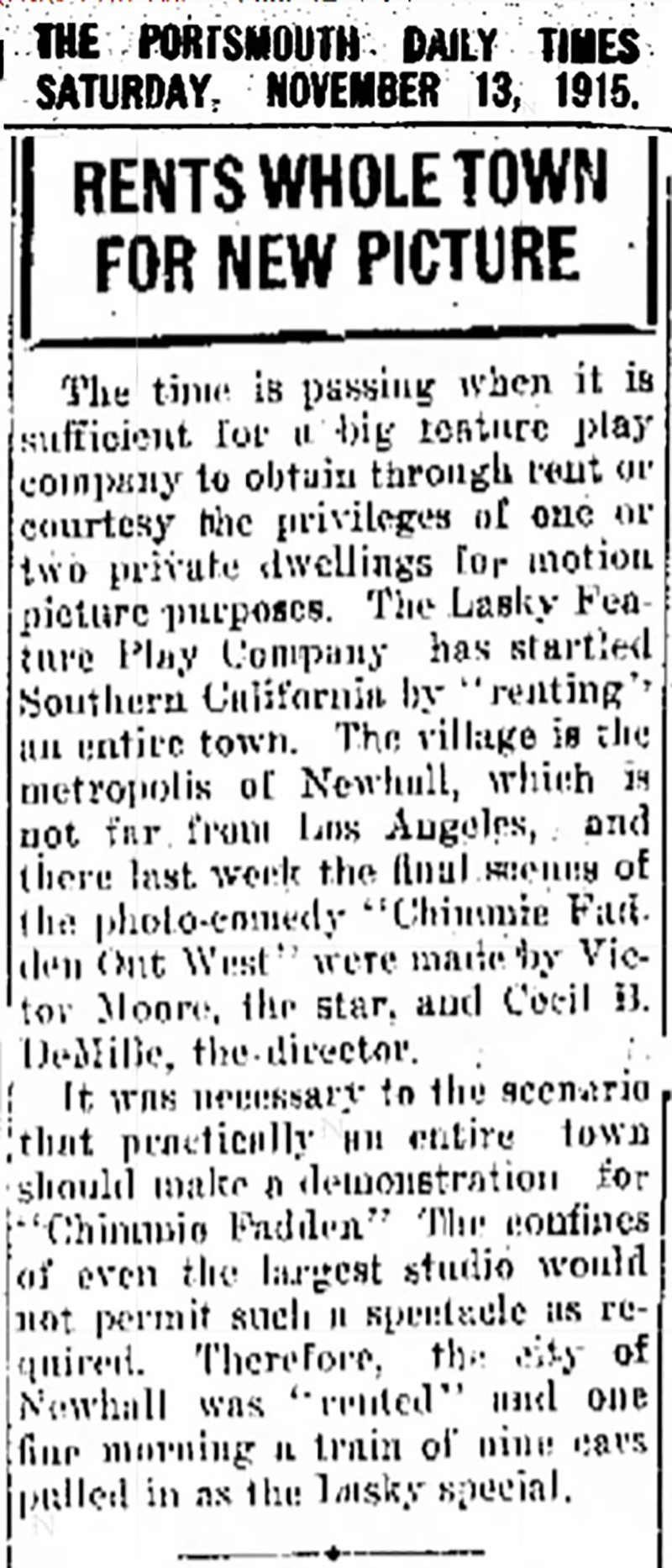|
|


Click image to enlarge
| Download archival scan
8x10 monochrome lobby card (standard size and type for the 1910s) showing Victor Moore as the title character and (probably) Camille Astor in 1915's "Chimmie Fadden Out West" from the Jesse L. Lasky Feature Play Co., a forerunner of Paramount.
Southern Californians of 1915 were "startled," the boosters declared, when Jesse L. Lasky rented "the entire town of Newhall" for the final scenes of a feature-length comedy called "Chimmie Fadden Out West," directed quite uncharacteristically by pioneer filmmaker Cecil B. DeMille. Moving-picture productions were getting so big, it was explained, the studio sets that dotted the Los Angeles area could no longer contain them. "The citizens of Newhall enjoy renting their fair city to motion picture companies," proclaimed Paramount Pictures, Lasky's exclusive distributor*, in an advertorial notice that ran in small-town newspapers. The production company rented everything in Newhall — "from the City Hall to the City Jail and including hotel, stores, railroad station and houses," along with a 9-car train. Exactly what was meant by "City Hall," we don't know; clearly, Paramount took some editorial license, going so far as to say money from filming "goes into the city strong box and helps reduce the tax rate." That might have been true if Newhall were an eastern city, but Newhall was neither eastern nor a city. No matter. Once considered lost, a print of the film turned up and has been preserved in the George Eastman House in Rochester, N.Y., so we might be able to figure out the locations one day. Perkins tells us DeMille stayed in the Swall Hotel before it burned down in 1917. It was rebuilt. "Chimmie Fadden Out West" was a 5-reel (50-minute) sequel whose release on November 21, 1915 coincided with the newspaper notices and came just five months after the release of the 4- or 5-reel original, titled "Chimmie Fadden" — a print of which exists in the Cinemateket-Svenska Filminstitutet in Stockholm, Sweden. The character, Chimmie, is the creation of author Edward W. Townsend, who penned short stories just before the turn of the 20th Century. Some of the stories were adapted to the vaudeville stage. Victor Moore evidently portrayed the title character on the stage before reprising the role in the films. It was about as unusual for a comedy to run 50 minutes in 1915 as it was for the maker of 1924's "The Ten Commandments" to direct one. "(DeMille's) vision of cinema, like D.W. Griffith's, was far more sober than that, at least in 1915," writes film historian Richard Koszarski (1990:174). "While dramatic subjects essentially abandoned shorts for features after 1915 ... relatively few feature-length comedies were produced before 1920," Koszarski notes. Audiences preferred their comedies in smaller bites, as warm-ups to the main feature on a Saturday afternoon. Both the original and the sequel co-star Raymond Hatton, who was no stranger to Newhall in later years as he starred opposite Buck Jones and Tim McCoy in the "Rough Riders" buddy pictures that filmed in Placerita Canyon in the early 1940s. Rounding out the cast are the female lead, Camille Astor; Mrs. Lewis McCord (birth name Bertha St. Clair), Ernest Joy, Tom Forman, Florence Dagmar and Harry Hadfield. DeMille is the director, producer, editor and co-writer. Cinematographer (cameraman) is Alvin Wyckoff. Death Valley locations were also used. *In 1915 the Lasky company, est. 1911, had not yet merged with Adolph Zukor's Famous Players, and Zukor had not yet bought out Paramount, with which Lasky had a distribution contract.
LW3511: 9600 dpi jpeg from original lobby card purchased 2018 by Leon Worden.
|
The site owner makes no assertions as to ownership of any original copyrights to digitized images. However, these images are intended for Personal or Research use only. Any other kind of use, including but not limited to commercial or scholarly publication in any medium or format, public exhibition, or use online or in a web site, may be subject to additional restrictions including but not limited to the copyrights held by parties other than the site owner. USERS ARE SOLELY RESPONSIBLE for determining the existence of such rights and for obtaining any permissions and/or paying associated fees necessary for the proposed use.




